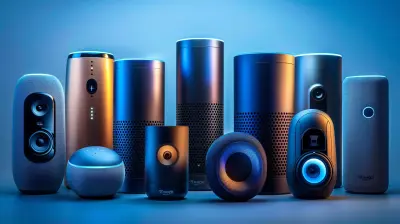How Voice Assistants are Evolving to Understand Emotion
11 June 2025
Have you ever shouted at your digital assistant in frustration because it just didn’t “get” what you were trying to say? Or maybe you were feeling down, but your smart speaker cheerfully rattled off the weather like everything was peachy? Yeah, we’ve all been there. But guess what? That kind of emotionally tone-deaf response might soon be history.
Voice assistants—think Alexa, Siri, Google Assistant, and their buddies—are growing up fast. And one of the most exciting leaps they’re making is learning to understand emotion. That’s right. These virtual helpers are starting to go beyond just hearing what you say… they’re starting to feel the vibe behind your words.
Let’s dig into how this is happening, what tech is making it possible, and what it means for our future with these ever-listening companions.
From Command Takers to Emotion Readers
In the early days, voice assistants were glorified command takers. You’d say, “Play jazz music,” and boom, Louis Armstrong. Great. But try telling your assistant, “I had a terrible day,” and it probably thought you were requesting a song called “Terrible Day.” Not helpful.Now, things are changing. The next generation of voice assistants is being trained not just to understand the words we say, but the way we say them. Tone, pitch, tempo, pauses, even sighs—all those little human quirks are becoming data points these systems can analyze.
It’s like teaching a robot to read between the lines.
The Science of Feeling: Emotional AI in Action
So, how do voice assistants actually start recognizing emotions? It’s no magic—it’s science. Specifically, it’s a mix of:1. Natural Language Processing (NLP) with Sentiment Analysis
At its core, NLP breaks down your speech into data points and interprets the meaning. Sentiment analysis goes a step further and tries to capture the emotional undercurrent. If you say, “I’m fine,” but your tone is flat or tense, a human might pick up on that sarcasm—and so can advanced NLP models now.These models are being trained on millions of emotional speech samples. They learn how people sound when they’re angry, sad, happy, tired, or stressed.
2. Voice Biometrics and Acoustic Features
Voice carries a lot more than words. Your vocal pitch rises when you're excited, slows down when you’re reflective, tightens when you’re anxious. Machine learning algorithms can now identify these subtleties.Imagine your virtual assistant noticing that your usual chipper morning greeting sounds unusually dull and proactively asking, “Is everything okay today?”
Creepy? Maybe a little. But also kind of amazing.
3. Contextual Awareness
Emotion isn’t just in the voice; it’s in the situation. That’s why new systems are built to consider context—from your calendar, smart home devices, and even past conversations.For instance, if your assistant knows you just missed an important meeting and now you sound frustrated, it can connect the dots without you spelling it out.
That’s empathy… or, at least, a digital version of it.
Real-World Examples: Who’s Leading the Charge?
Big tech isn’t just dabbling in emotion recognition—they’re investing heavily. Here’s a peek at some cool applications already rolling out:Amazon’s Alexa
Amazon is working on making Alexa more “emotionally intelligent.” In some regions, Alexa can already detect when you're sounding cheerful or disappointed and respond with a matching tone. It’s subtle but adds a layer of realism.Google Assistant
Google is integrating emotional cues into its assistant through advanced AI research projects. The focus is on making interactions more natural—like adjusting the assistant’s tone based on how you're speaking.Apple’s Siri
While Apple’s been tight-lipped, their patents suggest Siri could be learning to “perceive user emotion from voice input.” It’s only a matter of time before we see this in action.Startups and Innovators
Beyond the big players, companies like Affectiva and Beyond Verbal are pioneering emotion AI. These startups specialize in analyzing voice patterns to detect mood, stress levels, and even mental health indicators.
Why Does This Matter?
Now, you might be wondering: “Cool tech… but why should I care if my phone knows I’m grumpy?”Let’s break down the reasons why emotional intelligence in voice assistants is more than just a fancy feature.
✅ Better User Experience
Nobody wants a robotic response when they're upset or a chipper tone when they’re trying to unwind. Emotionally aware assistants can tailor responses in a way that feels human. That builds trust and comfort.✅ Mental Health Monitoring
This one’s big. Imagine a voice assistant that can detect early signs of depression or anxiety just by how you talk over time. It won’t replace a therapist, but it could give you a nudge to seek help when needed.✅ More Natural Conversations
Who doesn’t want to talk to their assistant like it’s a real person? Emotionally intelligent systems can make conversations flow more naturally—like chatting with a friend instead of issuing commands to a machine.✅ Improved Accessibility
For people with cognitive impairments or emotional processing challenges, these assistants could serve as helpful companions by adapting interactions in real-time based on emotional cues.The Roadblocks and Ethical Minefields
Of course, this level of intimacy between us and our devices comes with its share of challenges.🕵️♂️ Privacy Concerns
To read emotions, voice assistants need to listen closely—and constantly. That raises legit fears about surveillance and misuse of sensitive emotional data. Where’s the line between helpful and invasive?🤖 Accuracy Issues
Emotions are messy and complex. Even humans get it wrong all the time. How confident can we be that a machine won't misread our tone and respond inappropriately?⚖️ Ethical Responsibility
Should AI decide how we feel based on our voice? What if it makes decisions or recommendations based on incorrect assumptions about our emotions?These are the kinds of questions researchers, ethicists, and developers are tackling as we move forward.
What the Future Looks Like
We’re not talking about sci-fi anymore. The future of emotionally aware voice assistants is already taking shape. But there’s still room for massive growth.🎯 Hyper-Personalized Assistants
As the tech evolves, expect your voice assistant to “learn you” better than ever. How you sound when you’re tired, when you’re stressed, when you’re joyful—your assistant will start recognizing patterns unique to you.Think of it like having a digital companion that grows more in sync with you over time.
👥 Emotional AI Meets Social Robots
Combine emotional AI with robotics, and you've got companions like ElliQ or Pepper—robots designed to engage with people emotionally. Especially powerful in elderly care, where loneliness is a huge issue.🧠 Blending Emotion AI with Other Data
Future voice assistants could blend vocal emotion recognition with facial expressions, biometric data (like heart rate), and contextual info. A holistic view of your emotional state? That’s next-level AI.Final Thoughts
The idea that voice assistants can “understand” our emotions might have seemed wild just a decade ago. But today? It's not just possible—it's happening. These leaps in emotional AI are paving the way for more intuitive, supportive, and human-like interactions between us and our digital devices.Sure, there are hurdles to clear—ethical concerns, privacy questions, and technical limitations. But the potential here is massive. Imagine a world where your tech doesn’t just respond—it resonates.
So, the next time you vent to your smart speaker, don’t be surprised if it starts responding like a friend who truly gets you.
Because soon enough… it just might.
all images in this post were generated using AI tools
Category:
Voice AssistantsAuthor:

Marcus Gray
Discussion
rate this article
3 comments
Peregrine Morgan
This article brilliantly highlights the evolution of voice assistants in recognizing human emotions, enhancing user experience through more empathetic interactions. As AI continues to advance, the potential for deeper connections between technology and users grows, paving the way for more intuitive, responsive devices.
June 18, 2025 at 11:41 AM

Marcus Gray
Thank you for your thoughtful comment! I'm glad you found the article insightful; the evolution of voice assistants is indeed paving the way for more meaningful interactions.
Lillian McGeehan
Great insights! Emotion in voice tech is truly fascinating.
June 16, 2025 at 11:05 AM

Marcus Gray
Thank you! I'm glad you found it insightful—emotion in voice tech is definitely a game changer!
Raelyn Dodson
This article highlights a fascinating evolution in technology! Understanding emotion in voice assistants will undoubtedly enhance user experience and foster deeper connections.
June 11, 2025 at 12:29 PM

Marcus Gray
Thank you! I'm glad you found the article insightful. Emotion recognition in voice assistants is indeed a game changer for user interaction.



